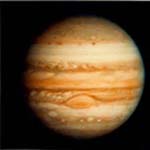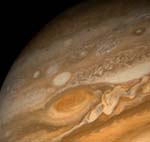![]()
Introduction
 Jupiter
is the largest planet in the solar system and the fifth from the Sun. It is a
very bright planet and it has a Great Red Spot and rings.
Jupiter
is the largest planet in the solar system and the fifth from the Sun. It is a
very bright planet and it has a Great Red Spot and rings.
Atmosphere
 There
are a series of bright zones and dark belts across the planet. The bright zones
lie above upward moving convection currents, higher than belts, and they have
high pressure. The dark belts, on the other hand, lie above downward moving
convection currents and they have low pressure.
There
are a series of bright zones and dark belts across the planet. The bright zones
lie above upward moving convection currents, higher than belts, and they have
high pressure. The dark belts, on the other hand, lie above downward moving
convection currents and they have low pressure.
Rings
They are produced by the impacts of meteoroids on Jupiter's inner moons and made up of dust and very small particles which cannot be seen from the Earth directly. They are transient as more materials could continually be added to it while others could fall into Jupiter.
Moons
Jupiter has at least 16 moons, 4 of which are large Galilean moons.
Io is the most geographically active body in the Solar System. It has a thin
temporary atmosphere of sulphur dioxide.
Europa is the smallest of the 4 Galilean moons. NASA reported
the possible discovery of liquid water under the ice.
Ganymede is larger than Mercury and Pluto and is the largest moon in the Solar
System.
Callisto is the outer most Galilean moon and it is the third largest moon in the
Solar System. It is also the darkest and least dense.
Special Features - Great Red Spot
Jupiter has a Great Red Spot (GRS), which is a very large (1 Earth diameter North-South and 2 Earth diameters East-West) and long-lived (300 years) storm.